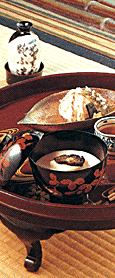
 KAISEKI RYÔRI KAISEKI RYÔRI
Japanese Haute Cuisine
Kaiseki is as much an art form as a style of cooking and food preparation. If you appreciate culinary delicacies, you'Il love kaiseki. Kaiseki menus offer a cornucopia of gastronomical treats including tempura, cooked seasonal fish and even sirloin steak in some cases. A kaiseki meal is imbued with the spiritual hush of the tea ceremony, its serene balance of food and utensil, and the visual celebration of nature's delicious bounty. Through five centuries, kaiseki's master chefs have preserved and passed on the secrets of their tranquil art, and knowledge of the harvest and spawning cycles of all manners of flora and fauna. They have set the standards of "Japanese" gourmet cooking. A kaiseki meal is the tongue-tingling zenith of the Japanese dining experience.
History of Kaiseki In 1749, the eighth Shogun, Yoshimasa Ashikaga, built a small, rustic teahouse which is now part of the Ginkakuji Temple in Kyoto. In its secluded environment he entertained guests, using exquisite utensils from foreign lands in the preparation of green tea (cha). In 1749, the eighth Shogun, Yoshimasa Ashikaga, built a small, rustic teahouse which is now part of the Ginkakuji Temple in Kyoto. In its secluded environment he entertained guests, using exquisite utensils from foreign lands in the preparation of green tea (cha).
 At first, the tea ceremony (cha-no-yu) which developed was the leisure pastime of nobility and the wealthy because of the large investment in a teahouse and elegant utensils. However, as time passed, a more humble version of the tea ceremony called wabizuki was developed, because hospitality and attention to detail were felt to be more important than the opulent displays popularized by Yoshimasa. Thus it became possible for anyone to participate in the tea ceremony. At first, the tea ceremony (cha-no-yu) which developed was the leisure pastime of nobility and the wealthy because of the large investment in a teahouse and elegant utensils. However, as time passed, a more humble version of the tea ceremony called wabizuki was developed, because hospitality and attention to detail were felt to be more important than the opulent displays popularized by Yoshimasa. Thus it became possible for anyone to participate in the tea ceremony.
 With the tea ceremony, there developed a small meal of a few choice morsels. These minimalist dishes were called kaiseki since the meal was similar in purpose to the warm stones (seki) which Buddhist priests put in their robes: to forget their empty stomachs (kai) while studying and meditating. Kaiseki restaurants and their Kyoto variants, the kyo-ryori restaurants, remain today one of the main learning centers for the art of the tea ceremony. With the tea ceremony, there developed a small meal of a few choice morsels. These minimalist dishes were called kaiseki since the meal was similar in purpose to the warm stones (seki) which Buddhist priests put in their robes: to forget their empty stomachs (kai) while studying and meditating. Kaiseki restaurants and their Kyoto variants, the kyo-ryori restaurants, remain today one of the main learning centers for the art of the tea ceremony.
 Although the name kaiseki reveals its Buddhist roots, the essence of the food service comes from traditional Japanese Shinto beliefs regarding the primacy of nature. The four seasons and seasonal foods are the cornerstones. Although the name kaiseki reveals its Buddhist roots, the essence of the food service comes from traditional Japanese Shinto beliefs regarding the primacy of nature. The four seasons and seasonal foods are the cornerstones.

|